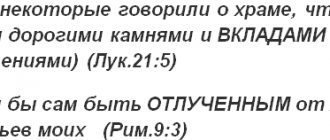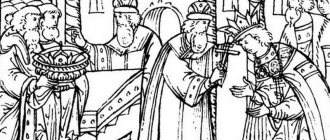Why are they excommunicated from the Church?
The word “anathema” is of Greek origin, literally translated as “excommunication.” In church practice, it means prohibiting a Christian from participating in the life of the church community and partaking of the holy gifts. Is imposed for the most serious sins:
- deviation into heresy,
- split.
It is proclaimed conciliarly in the first week of Great Lent during a special rite called the Triumph of Orthodoxy.
Triumph of Orthodoxy
History of the origin of the term and its use in the Bible
Etymologically, it goes back to the Greek word “anatifimi”, that is, “to lay down”, “to impose”, to hand over something to someone.” In its initial essence, it is a sacrifice to a deity, made in fulfillment of a vow. We first find mention of anathema in ancient Greek authors (Sophocles, Homer, Herodotus) in the interpretation of “a certain object used as a temple offering as a gift to the gods.”
Useful materials
In the Bible, when translating the book from Greek, the word “anathema” undergoes a distortion of meaning and is used in the meaning of “curse,” “exile,” “that which is subject to destruction.”
If we turn to the canonical texts, in the first letter to the Corinthians, the Apostle Paul says: “Whoever does not love the Lord Jesus Christ is anathema, maran-atha” (1 Cor 16.22). That is, cursed until “maran-afa” - the Lord comes and decides the fate of the sinner.
Interesting fact
In church practice, the word “anathema” came into use as a term in the 4th century.
Anathema = curse? Week of the Triumph of Orthodoxy
Open the dictionary of S.I. Ozhegova: “Anathema is a curse (previous church curse, excommunication).” "Church curse"? But can Christians curse, about whom St. Gregory the Theologian wonderfully said: “If someone asked us what we feel and what we worship? The answer is ready: We honor love”? Love, which, as the Apostle Paul wrote, “thinks no evil,” is incompatible with damnation. And Christians, and especially the Church, cannot curse. Then what is it? Is there really an error in the authoritative dictionary? Let's try to figure it out.
In the Greek translation of the Bible (Sertuaginte), the word "anathema" was used to mean something cursed, rejected by people. In this sense, the word “anathema” is used in the 1st letter of the Apostle Paul to the Corinthians: “Whoever does not love the Lord Jesus Christ is anathema...” (1 Cor. 16:22).
For some reason, the belief has spread that “anathema” means surrender to Satan. However, this is not true. Anathema is not a curse (although it is written as such in Dahl’s dictionary), but excommunication from the Church of persons whose thoughts and actions threaten the purity of doctrine and the unity of the Church. This is not so much a condemnation of an excommunicated person as a way to protect other believers from communication with him and the possible temptation to follow an extra-church, untrue path. A kind of preventive measure.
A similar practice (excommunication from the synagogue) existed in Judaism. In particular, it was applied to Christians because they recognized Jesus as the Christ - the Messiah.
As for dictionary entries, the point is as follows. Today we perceive a curse as a calling upon a person of evil. But earlier the word “curse” was synonymous with “anathema” and meant precisely excommunication from the Church. Although, along with it, there was also the familiar meaning of the verb “to curse” - “to call upon someone disaster, to wish evil upon someone” (“Explanatory Dictionary of the Living Great Russian Language by V.I. Dahl”).
Why are we talking about anathema? The fact is that the rite of anathematization is directly related to the Week of the Triumph of Orthodoxy.
In the 8th century. Opponents of icons appeared in the Byzantine Empire. These people believed that images of saints were the same as pagan idols. And prayer in front of an icon is real idolatry. (And today you can hear the opinion that Christians pray to an icon, and not to a saint in front of his icon. But this is a big difference!)
Naturally, Christians rebelled against the iconoclasts. A fierce struggle began. Saving icons, Christians risked their lives. But their jealousy sometimes crossed boundaries, and they were ready to tear apart the opponents of the icons. The confrontation was complicated by the political struggle of the Byzantine rulers and resulted in a real civil war.
To put an end to the schism among Christians, the church fathers convened the VII Ecumenical Council in 787 and officially approved the veneration of icons. However, for almost a whole century, in remote areas of the Byzantine Empire, iconoclasts persecuted believers. The end of the confrontation was put on February 19, 843, on the first Sunday of Great Lent. On that day, the celebratory rite of the Triumph of Orthodoxy was served in the Cathedral of St. Sophia in Constantinople, the veneration of icons was once again approved, and iconoclasm was recognized as a heresy. Now the rite of the Triumph of Orthodoxy is served in churches on the first Sunday of Great Lent in memory of the victory over iconoclasm and symbolizes the triumph of the Church over all heresies and schisms that have ever existed.
The Byzantine queen Theodora, during whose reign the veneration of icons was restored, declared: “Whoever does not honor the image of our Lord, His Most Holy Mother and all the saints, let him be cursed!” This is probably related to the introduction of the rite of anathematization (excommunication from the Church) into the service, and possibly the perception of the word “anathema” as a “curse.” This rite contains the reading of the Creed, the pronouncing of anathema and the proclamation of Eternal Memory to all defenders of Orthodoxy.
In Orthodoxy, anathema was applied after repeated attempts to call a sinner to repentance.
The official proclamation of anathema meant that a person could not participate in the sacraments, attend church and claim burial according to the Christian rite. Since anathema is not a punishment, not a mark for life, the one who has been anathematized can return to the fold of the Church. This procedure consists of the (usually public) repentance of the anathematized person and a decision on his forgiveness.
The rite of the Triumph of Orthodoxy in Russia gradually underwent changes. At the end of the 15th century, the names of the leaders of the “Judaizers” heresy were included in it. When state control over the Church increased, state criminals began to be anathematized: Grigory Otrepyev, Stepan Razin, Mazepa. The rebel Stefan Glebov was anathematized not by a council of bishops, but by an imperial decree of Peter I. Of course, heretics were also anathematized, for example, the Old Believer Archpriest Avvakum. Over time, about 4 thousand names of those anathematized were accumulated! And it became customary to list the names of heresies without mentioning heretics, and instead of remembering the names of state criminals, a general phrase appeared about “those daring to revolt” against “Orthodox sovereigns.”
The excommunication of L.N. is still controversial. Tolstoy. A hundred years after this event, the great-grandson of the writer turned to the Patriarch with a letter in which he asked to lift the anathema from the writer. The excommunication was not lifted, and in a response to correspondents on this issue, Alexy II said: “We do not deny that he is a literary genius, but he has clearly anti-Christian works; Do we have the right, after 100 years, to impose on a person what he refused?”
L. Tolstoy’s anathema is evidence of the Church that if a person of his own free will has chosen a non-Church path of life, the Church cannot force him to follow the Christian path again, that is, the freedom of choice to be or not to be with the Church is reserved for the person.
In the modern life of the Orthodox Church, anathema is not proclaimed. Today, the Week of the Triumph of Orthodoxy is, first of all, a celebration of the victory of truth.
https://www.taday.ru/text/98945.html
What does it mean to “anathematize”?
In a secular understanding, anathema looks like a curse of the Church on a specific person. This is incorrect, because the church does not curse, but excommunicates those who, through their lifestyle, thinking, and actions, have renounced Christian dogmas and church rules. The Church, declaring anathema, openly testifies that this person is outside her body, deprived of her prayerful care and guardianship. The essence of punishment lies not so much in the formal prohibition to participate in divine services and Sacraments, but in the real loss of grace, the right to salvation and eternal life.
Origin of the term and its meaning
The word anathema came into our speech from the Greek language. At first it meant “separation” from the verb ἀνατίθημι - “to lay down”, “to put aside”, that is, sacrifice or dedication to God by vow. Gradually, the word changed its meaning and began to mean expulsion, or excommunication from society, a curse.
In common parlance, anathema means a curse; the word was used as a swear word - anathema, anathema.
In Orthodoxy, the word anathema is understood as:
- rites of those united from other faiths to the Orthodox Church;
- ceremony for the holiday of the Triumph of Orthodoxy with the proclamation of anathema to heretics and the dogmas of faith, the singing of “Eternal Memory” to the deceased and many years to the living;
- anathema - public excommunication of a Christian from the Church, a ban on participation in the sacraments of the Church; eruption from Church members.
Anathema is the most severe church punishment that follows for grave sins against the Church - deviation into heresy, blasphemy against the Church, conscious unrepentance for these sins. The decision to anathematize is made conciliarly and in extremely rare cases.
A person anathematized no longer belongs to the bosom of the Church, he becomes a stranger to the faithful, excommunicated from communication with the Church and its members until he publicly repents.
Many understand anathema as a church curse. In fact, the Church does not curse apostates, but calls the guilty to repentance, this is the last call to come to their senses. Anathema is the placing of someone or something into absolute possession. In the church understanding, anathema is the transfer of a Christian to the Judgment of God. The Church relieves itself of worries about a person, stops praying for him, and transfers him to God. The declaration of anathema indicates that a person, even if he called himself a Christian, is not one: his actions, attitude, and views run counter to those of the Church.
Is it possible to remove it?
Despite the fact that anathema, unlike penance, is not temporary, but permanent, it can be canceled. To do this, a person anathematized must bring public repentance and sincerely repent of his sins. According to Christian doctrine, no one can be deprived of the right to salvation, because this contradicts the basic law of Christianity - love for your neighbor.
Only the Supreme Judge can exercise final judgment over people. However, the Catholic and Orthodox churches have different views on this issue. If in the East the anathema is subject to cancellation, then in the West this act is final and irrevocable.
Can the anathema be lifted
An anathema is not an eternal sentence, because it can be lifted, not only during life, but also posthumously.
The anathema can be lifted if the person repents. Of course, it must be sincere. In addition, the person must provide substantial evidence that he has changed his views.
The decision to lift the anathema has the right to be made only by the Council of Bishops by which it was made. This decision is formalized accordingly and transmitted to the person in respect of whom it was made.
Found a violation? Report content
In what cases does anathematization occur?
Anyone who deliberately distorts official religious doctrine or rejects the Church as an institution of power, not recognizing its influence over him, but, nevertheless, remaining faithful to its dogmas, can be subjected to anathema. This applies to heretics, false teachers and schismatics.
Anathema is the highest punishment, and therefore is proclaimed only in extreme cases. It must always be preceded by an attempt by the confessor to convince the sinner of his wrongness through instruction and bringing him to repentance.
How to remove anathema
Anathema does not prevent one from returning to the Church and, therefore, does not block the path to salvation. If the offender admits his wrongs, he can repent and join the Church. Removing an anathema is a complex legal process.
In order to return to the Church, you will need to publicly repent, turning to the body of church authority that anathematized you.
If the culprit sincerely repented, fulfilled the punishment, and cannot cause spiritual harm to other members of the Church, the anathema will be lifted. It is possible to lift the anathema after death, which gives the right to church commemoration of the deceased. What is anathema?
Excommunication during the Ecumenical Councils
Anathematization of Nestorius at the Third Ecumenical Council. Fresco of Dionysius. 1502
As a legal verdict, anathema was first pronounced at the First Ecumenical Council in the 4th century by the presbyter of the Alexandrian Church, Arius, for spreading a heresy about the nature of the Holy Trinity. Later, other Ecumenical Councils strengthened its position as a church disciplinary sanction, and already in the early Middle Ages the traditional form of anathematization was finally consolidated: “Let the name be anathema.” Perhaps the most famous example of the proclamation of anathema is the VII Ecumenical Council, at which the iconoclasts were excommunicated from the Church.
Mutual excommunications of 1054 and the split of churches into Orthodox and Catholic
July 1054 Papal envoys - legates, headed by Cardinal Humbert - enter the Church of Hagia Sophia in Constantinople. Their goal is not prayer. The cardinal holds tightly in his hands a bull - a document sealed with lead and containing accusations against the then Patriarch Michael Cerullarius. The papal letter ended with the following words:
“...By the authority of the Holy and indivisible Trinity, the Apostolic See, of which we are ambassadors, [the authority of] all the holy Orthodox fathers of the Seven [Ecumenical] Councils and the entire Catholic Church, we sign against Michael and his adherents - the anathema that our most reverend Pope pronounced against them , if he doesn’t come to his senses.”
Papal legates proclaim anathema to the Patriarch of Constantinople
So, Pope Leo IX, who had been dead for three months, deposed the Patriarch of Constantinople, and with him anathematized the entire Eastern Church.
The situation was ambiguous, but Michael Cerullarius did not want to resolve the conflict with the new papal successor. Literally a week later, he convened a council in the capital of the Byzantine Empire, at which the legates, including the future pontiff Stephen IX, were anathematized .
The anathema did not apply to the entire Western Church, but the opinion was firmly established in the popular consciousness that all Latins were subject to excommunication. The same applied to the West - in their understanding, the entire East was subjected to punishment.
This conflict led to the split of the united Church into the Roman Catholic and Greek Orthodox, marking the beginning of mutual alienation and hostility, which only strengthened over the years. Historians unanimously call this schism the Great, although it did not make any significant changes in the life of the Christians of that time: in matters of dogmatic, liturgical and canonical nature, the Latins and the Orthodox had been disagreeing for a long time.
For example, according to Western custom, bread for the Sacrament of the Eucharist was made on unleavened bread, that is, on unleavened dough, and according to Eastern custom, on yeast dough. The dispute over what should be done resulted in an unprecedented action: Michael Cerullarius ordered the closure of all Latin churches in Constantinople, and the unleavened bread, symbolizing the Body of Christ, to be thrown out of the tabernacles. It is believed that this is one of the formal reasons that led to the sending of the papal embassy to the capital of the Byzantine Empire and the anathema.
Interesting fact
Of course, there were many reasons for this, the main one of which was Rome’s claims to absolute power over the Church. Pope Leo IX openly stated this in a bull.
Be that as it may, relations between the Churches were officially severed. And, despite the fact that in 1964 the anathemas were mutually lifted by the then heads of the two Churches, this fact did not put an end to historical strife and did not have any significant impact on further relations between East and West.
Why were political criminals excommunicated?
In the history of Tsarist Russia, there were frequent cases when state criminals were subjected to excommunication.
Grishka Otrepiev, Ivashka Mazepa, Emelka Pugachev and Stenka Razin... This is exactly what their names sounded like during the reading of the rite of anathematization. These people did not deny the dogmas of the Orthodox faith and did not create sects. Why were they anathematized? By their actions they posed a serious political threat and undermined the foundations of state unity.
At that time, the institutions of state and church were a single mechanism that looked after each other’s interests. Crimes against the Sovereign, God’s anointed, were equated to a crime against the Power, which for centuries had been the stronghold of Orthodoxy. That is why those guilty of high treason were judged by the Church.
What about Tolstoy?
“Dear Empress Countess Sofia Andreevna! It’s not cruel what the Synod did by announcing your husband’s fall from the Church, but cruel what he did to himself by renouncing his faith in Jesus Christ, the Son of the Living God, our Redeemer and Savior.”
This is an excerpt from a letter sent by Metropolitan Anthony to the wife of Leo Tolstoy in response to her appeal to the Holy Synod.
25
February
2019
The Message of the Holy Synod was published in all the main metropolitan newspapers of the Russian Empire, which officially announced that Count Leo Tolstoy was no longer a member of the Orthodox Church.
This decision shocked public thought; encouraging letters filled with sympathy were sent to the writer from all sides. They quickly responded to gather their pen: Kuprin’s story “Anathema” appears in artistic periodicals. From the point of view of literary form, it is a remarkable work, but in its essence it is pure fiction.
The main character of the work is Protodeacon Father Olympius, “a great formalist, a pedant and a capricious person,” who never allowed himself to miss a single line from the liturgical books. He faces the difficult task of anathematizing his beloved writer. However, during this procedure, the unexpected happens: instead of excommunicating the writer from the Church, the priest proclaims “many years to come” from the pulpit. Father Olympius can be understood, because the missal that Kuprin “wrote” for him contains terrible curses against Tolstoy.
These words are more like the spells of some shaman than excerpts from an official document. Never in any rite compiled by the Orthodox Church has there been anything similar to Kuprin’s expressions. In addition, anathema to Tolstoy was not officially proclaimed, and the count’s name was not included in the lists of anathematization. What happened?
The Message, in a very delicate formulation, stated the fact of Lev Nikolaevich’s falling away from the Church, which the writer himself confirmed more than once. The word “anathema” itself was not used even once in the document, most likely precisely because of the connotation of odiousness inherent in this term among the broad masses.
Tolstoy was to be excommunicated from the church community “... until he repents and restores his fellowship with her.”
But Tolstoy was not going to go to peace. Moreover, in a letter addressed to Metropolitan Anthony of St. Petersburg and Ladoga, the count confirmed his contempt for the teachings of the church, calling it “a collection of the most stupid superstitions and witchcraft,” and rejected the Trinity, Christ and the Sacraments. In his further work and worldview, the writer steadfastly adhered to the Gospel of Tolstoy - a semantic reworking of canonical texts, from which Lev Nikolaevich threw out everything that seemed “unnecessary” to him.
The religious ideology of the Russian writer gave rise to an entire movement - Tolstoyism, which covered wide sections of the population. Communities that professed non-resistance to evil through violence were created everywhere in Russia, and not only in it. Followers of Tolstoy appeared even in England, Western Europe, South Africa, Japan and India!
The Russian Orthodox Church certainly had to respond to the spread of heresy and, in an act of renunciation, formally isolated Tolstoy from communication with the “faithful.” Tolstoy became like a “tempting hand,” and therefore the Church, following the commandment of Christ, cut him off from itself.
“And if your right hand causes you to sin, cut it off and throw it away from you, for it is better for you that one of your members should perish, and not that your whole body should be cast into hell” (Matthew 5:27-30).
Did Tolstoy suffer from this renunciation? Probably, the writer himself answered this question best: he ordered to bury himself without “any spells and prayers”...
And a few more names
World history knows several more cases of excommunication, in which famous names appeared:
- in 1970, anathema was proclaimed to the leader of the world proletariat - Lenin, posthumously;
- in 1918, Patriarch Tikhon twice anathematized the Bolsheviks and their leaders “who create lawlessness and persecute the faith and the Orthodox Church”;
- Metropolitan Filaret (Mikhail Denisenko) was defrocked in 1992, and in 1997 by the Council of Bishops of the Russian Orthodox Church he was excommunicated from the Church through anathematization;
- former priest Gleb Yakunin was expelled from the Russian Orthodox Church for “arbitrarily wearing a priest’s cross and priestly robes” in 1997. Founder and leader of the Apostolic Orthodox Church.
Is anathema a church curse?
Estimated reading time: 3 minutes.
Anathema is not a “church curse”, but the complete excommunication of a person from the Church for grave sins - a deliberate distortion of dogmas (heresy) or division within the Church (schism). In practice, it looks like this: a person can no longer participate in church sacraments, the main one of which is Communion.
We wrote more about this in the special project “Thomas” EXPLANATORY DICTIONARY in the material “Anathema: Execution beyond the fence of the Church, not a curse.” Now let’s talk briefly:
According to the Orthodox Encyclopedia, the term “anathema” was originally Greek (ἀνάθεμα, ἀνάθημα) and meant among pagan authors “something dedicated to God; a gift, an offering to the temple” - that is, something separate, not used in everyday life. It was also used in the Greek translation of the Bible to convey the Hebrew term "herem" , which means something cursed and rejected. This is how the word “anathema” acquired its negative connotation.
Holy Fathers and Disgraced Heretics. Fresco of the narthex of the Pech Patriarchate Monastery in Kosovo (XVI century)
The Church considers schism and heresy to be among the most serious sins: schismatics and heretics not only themselves retreat from the Church, encroach on the foundations of its teaching and unity, but also seduce other believers to do so. Therefore, the Church is forced to protect its members from communication with them through excommunication - anathema.
There are two types of excommunication from the Church: “minor excommunication” and anathema. “Minor excommunication” is the temporary exclusion of a person from the church community and a ban on participation in the sacraments. This type of church punishment is imposed for a certain time - from several months to several years for the most serious sins, such as fornication, theft and others, after the person has repented and stopped sinning. An anathema is proclaimed for an indefinite time, until a person repents of his actions, thereby not depriving him of hope for salvation, but indicating to everyone that he is sinning against the Church and everyone who follows him will also leave the Church and will be guilty of sin against her. Anathema is given only after repeated exhortations to a person to repent.
Only a member of the Church can be anathematized, that is, at least a baptized person who considers (or considered) himself Orthodox and participated in church sacraments. Therefore, an atheist or agnostic cannot be anathematized - such a person initially did not consider himself a Christian and was never a member of the Church.
The most famous “anathematized” person is Lev Nikolaevich Tolstoy. The writer spoke out against the Church more than once, and then began to completely distort its teaching. His colossal authority and popularity were a source of great temptation for the intelligentsia of that era. The famous writer not only himself held anti-church, sometimes downright blasphemous religious views, but also claimed to be a kind of religious teacher. In 1901, for “the overthrow of all the dogmas of the Orthodox Church and the very essence of the Christian faith,” the Holy Synod decreed: “The Church does not consider him its member and cannot consider him until he repents and restores his communion with her.” Technically, the word “anathema” was not uttered, but the essence is the same. Read more about this here.
One of the last to anathematize was the former Metropolitan of Kyiv Philaret (Denisenko) for a schism in the Church (the creation of the so-called Ukrainian Orthodox Church of the Kyiv Patriarchate). The Council of Bishops of the Russian Orthodox Church in 1997 decided: “To excommunicate monk Philaret (Mikhail Antonovich Denisenko) from the Church of Christ. Let him be anathema before all the people." Before this, the schismatic was deprived of all degrees of the priesthood and was repeatedly called to repent.
In the Russian Orthodox Church, the current bishop in his diocese, the Patriarch and the Holy Synod can anathematize, but only after a decision of the Church Court.
Rite of the Triumph of Orthodoxy
Triumph of Orthodoxy
843... The Orthodox world finally overcame the heresy of iconoclasm. In memory of this significant event, a holiday was established, called the Triumph of Orthodoxy. It is celebrated in the first week of Lent. A little later, by the 11th century, a special order was formed that included the dogmas of the Orthodox Church and approved the decisions of seven Ecumenical Councils, and along with this - anathema to all atheists, heretics, as well as persons who were considered traitors to the Fatherland.
The rite constantly underwent changes: the lists of persons subject to anathema expanded due to the constant emergence of new heresies and enemies of the Church. By the end of the 18th century, an opposite trend emerged: the lists began to be shortened, since there were up to 4 thousand names on them!
Interesting fact
By 1869, references to civil criminals, schismatic teachers, and Old Believers disappeared from the rank.
Nowadays, the Rite of the Triumph of Orthodoxy is not church-wide, and the part associated with anathematization is often omitted altogether. According to some priests, this is due to the irrelevance of the anathematisms themselves. Many heresies have become anachronisms, that is, relics of antiquity. In the current situation, when a huge number of new false teachings are emerging, it is a little irrational to mention what happened one and a half thousand years ago and remain silent about modern pseudo-Christian teachings.










